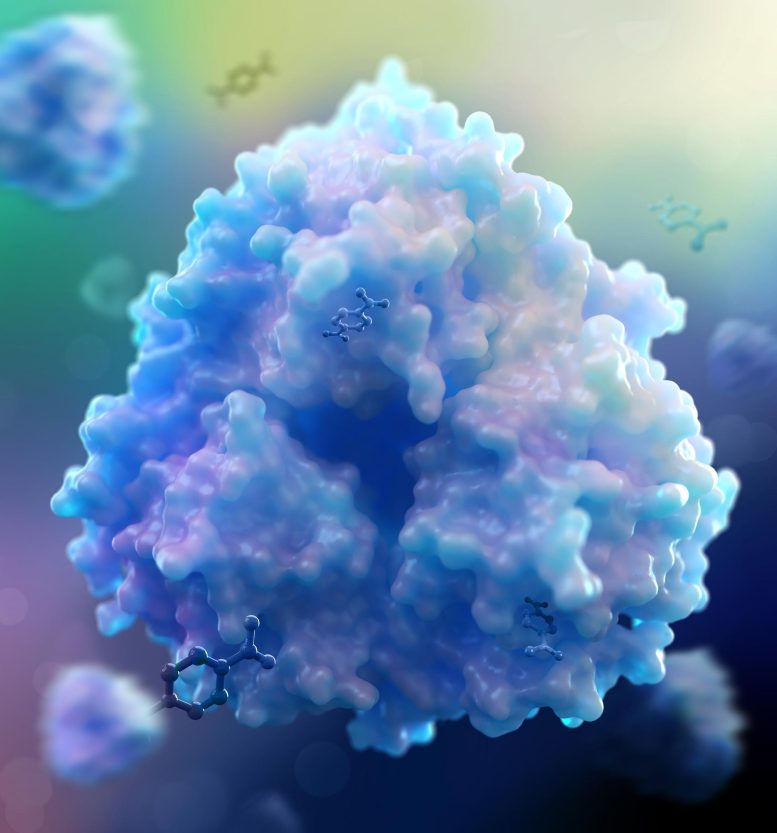
L’enzyme TPADO. Crédit : Rita Clare, Université d’État du Montana.
Les scientifiques qui ont été les premiers à utiliser des enzymes pour manger le plastique ont franchi une nouvelle étape importante dans le développement de solutions naturelles à la crise mondiale du plastique.
Les scientifiques qui ont contribué à mettre au point l’utilisation d’enzymes pour manger du plastique ont franchi une étape importante dans le développement de solutions naturelles à la crise mondiale du plastique.
Ils ont caractérisé une enzyme qui a la capacité remarquable d’aider à décomposer le téréphtalate (TPA), l’une des composantes chimiques du plastique polyéthylène téréphtalate (PET), qui est utilisé pour fabriquer des bouteilles de boissons à usage unique, des vêtements et des tapis.
La recherche, qui est publiée dans The Proceedings of the National Academy of Sciences (PNAS)., a été codirigée par le professeur Jen DuBois, de l’université d’État du Montana, et le professeur John McGeehan de l’University of Portsmouth, who in 2018 led the international team that engineered a natural enzyme that could break down PET plastic. The enzymes (PETase and MHETase) break the PET polymer into the chemical building blocks ethylene glycol (EG) and TPA. This new research describes the next steps, specifically for managing TPA.

Professor John McGeehan. Credit: Stefan Venter, UPIX Photography
Professor DuBois said: “While EG is a chemical with many uses – it’s part of the antifreeze you put into your car, for example – TPA does not have many uses outside of PET, nor is it something that most bacteria can even digest. However, the Portsmouth team revealed that an enzyme from PET-consuming bacteria recognizes TPA like a hand in a glove. Our group at MSU then demonstrated that this enzyme, called TPADO, breaks down TPA and pretty much only TPA, with amazing efficiency.”
With more than 400 million tons of plastic waste produced each year, the overwhelming majority of which ends up in landfills, it is hoped this work will open the door to improve bacterial enzymes, such as TPADO. This will help tackle the challenge of plastic pollution and develop biological systems that can convert waste plastic into valuable products.
Professor McGeehan, who is the Director of the University’s Centre for Enzyme Innovation, said: “The last few years have seen incredible advances in the engineering of enzymes to break down PET plastic into its building blocks. This work goes a stage further and looks at the first enzyme in a cascade that can deconstruct those building blocks into simpler molecules. These can then be utilized by bacteria to generate sustainable chemicals and materials, essential making valuable products out of plastic waste.
“Using powerful X-ray at the Diamond Light Source, we were able to generate a detailed 3D structure of the TPADO enzyme, revealing how it performs this crucial reaction. This provides researchers with a blueprint for engineering faster and more efficient versions of this complex enzyme.”
Reference: “Biochemical and structural characterization of an aromatic ring–hydroxylating dioxygenase for terephthalic acid catabolism” by 21 March 2022, Proceedings of the National Academy of Sciences.
The study was undertaken as part of the BOTTLE Consortium, an international collaboration between the US and UK, bringing together researchers from across a wide range of scientific areas to tackle plastic recycling and upcycling.



